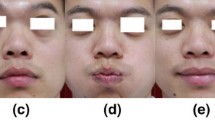Abstract
To provide physicians with an objective and quantitative measurement of single-sided facial paralysis, the paper presents a computer-based approach that is different from the nine existing, subjective and hand-performed international scales, such as House-Brackman. For voluntary expressions of a patient, this approach used Pface, which stems from Dface, to measure the asymmetry between two sides of the face and used eigenflow to measure the expression variations between the patient and normal subjects. The results from Pface and eigenflow were then combined by the support vector machine produce to Pdegree. A study of 25 subjects revealed that Pdegree could differentiate paralysis states (Pdegree≧0) and normal states (Pdegree<0), with the ability to grade facial paralysis automatically. Moreover, the Pface of specific facial areas can be used in the supervision of the rehabilitation process.
Similar content being viewed by others
References
Feris, R., Campos, T., andCesar, R. (2000): ‘Detection and tracking of facial features in video sequences’, in ‘Lecture notes in artificial intelligence, Vol. 1793’ (Springer-Verlag, 2000),4, pp. 127–135
Sich, U. (1981): ‘Surgery for Bell's palsy‘,Arch. Otolaryngol.,1, pp. 1–11
Frey, M., Jenny, A., andGiovaoli, P. (1994): ‘Development of a new documentation system for facial movements as a basis for the international registry for neuromuscular reconstruction in the face’,Plast. Reconstruct. Surg.,7, pp. 1334–1349
Gebhard, A., andPaulus, D. (2000): ‘A system for diagnosis support of patients with facial paralysis’, In KI, Bd. 2000,3, pp. 40–42
Helling, T. D., andNeely, J. G. (1997): ‘Validation of objective measures for facial paralysis’,Laryngoscope,10, pp. 1345–1349
Johnson, P. C., Brow, H., andKuzon, W. M. (1994): ‘Simultaneous quantification of facial movements: The maximal static response assay of facial nerve function’,Ann. Plastic Surg.,5, pp. 171–174
Liu, Y., andMitra, S. (2003): ‘Facial asymmetry quantification for expression invariant human identification’,Computer Vision and Image understanding Journal,7, pp. 138–159
Lucas, B. D., andKanade, T. (1981): ‘An iterative image registration technique with an application to stereo vision’, Int. Joint Conf. on Artificial Intelligence, Vancouver, Canada, pp. 674–679
Pillsbury, H. C., andFisch, U. (1979): ‘Extratemporal facial nerve grafting and radiotherapy’,Arch. Otolaryngol.,105, pp. 441–446
Yacoob, Y., andDavis, L. (1996): ‘Recognizing human facial expressions from long image sequences using optical flow’,IEEE Trans. Pattern Anal. Mach. Intell.,6, pp. 636–642
Author information
Authors and Affiliations
Corresponding author
Rights and permissions
About this article
Cite this article
Wang, S., Li, H., Qi, F. et al. Objective facial paralysis grading based onP face and eigenflow. Med. Biol. Eng. Comput. 42, 598–603 (2004). https://doi.org/10.1007/BF02347540
Received:
Accepted:
Issue Date:
DOI: https://doi.org/10.1007/BF02347540




